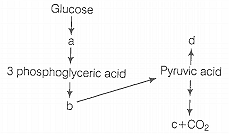The metabolic pathway given in the figure is fermentation. The products marked as a, b, c and d represents
a—Glyceraldehyde 3 phosphate
b—Phosphoenol pyruvic acid
c—Ethanol
d—Lactic acid
The fermentation is of two types
(i) Alcohol Fermentation In Yeast Fermentation is an incomplete oxidation of glucose under anaerobic condition. Alcohol fermentation in yeast occurs in 2 sets of reaction thus, converting pyruvic acid into ethanol and CO2 .
A. In the first step, pyruvic acid is decarboxylated (equation i), resulting in the formation of acetaldehyde and CO2.
...(i)
B. In the second step acetaldehyde is reduced to alcohol by NADH2 (equation (ii))

...(ii)
(ii) Lactic Acid Fermentation in Muscles
In animal tissue like muscles, during exercise, when oxygen is inadequate for cellular respiration pyruvic acid is reduced to lactic acid by lactate dehydrogenase. The reducing agent is NADH + H
+ which is reoxidised to NAD
+ in the subsequent processes.
Two applications of fermentation process are
(i) It helps in manufacture of ethyl alcohol.
(ii) It also helps in curdling of milk to make curd aided by bacteria Lactobacillus.


 ...(ii)
...(ii)